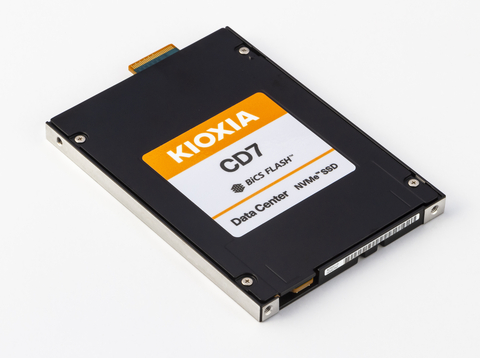
TOKYO, Japan:
Kioxia Corporation today announced that its lineup of KIOXIA CD7 Series EDSFF (Enterprise and Datacenter Standard Form Factor) E3.S NVMe™ SSDs are now available on servers and storage from Hewlett Packard Enterprise (HPE).

KIOXIA CD7 E3.S Series Data Center NVMe(TM) SSDs (Photo: Business Wire)
The industry’s first[1] EDSFF drives designed with PCIe® 5.0 technology, KIOXIA CD7 Series E3.S SSDs increase flash storage density per drive for optimized power efficiency and rack consolidation[2]. HPE ProLiant Gen11 servers, HPE Alletra 4000 data storage servers and the HPE Synergy 480 Gen11 Compute Module are enabled with the latest PCIe® 5.0 interface, enabling up to twice the performance over PCIe® 4.0, and come with optionally equipped EDSFF E3.S drive bays.
As a natural evolution of the 2.5-inch form factor[3], EDSFF E3.S is designed for the needs of high performance flash storage. E3.S enables more dense, efficient deployments in the same rack unit compared to 2.5-inch drives, while improving cooling and thermal characteristics and raising capacities by up to 1.5 to 2x.
Available in capacities from 1,920 to 7,680 gigabytes (GB), KIOXIA CD7 E3.S Series data center-class NVMe™ 1.4 SSDs conform to the EDSFF E3.S specification and feature read-intensive 1 DWPD[4] endurance.
Related Link: Product Page of KIOXIA CD7 E3.S Series
https://www.kioxia.com/en-jp/business/ssd/data-center-ssd/cd7-r-e3s.html
Notes
[1] As of November 9, 2021, based on industry survey of publicly available information.
[2] Compared to 2.5-inch form factor SSDs.
[3] 2.5-inch indicates the form factor of the SSD and not its physical size.
[4] DWPD: Drive Write(s) Per Day. One full drive write per day means the drive can be written and re-written to full capacity once a day every day under the specified workload for the specified lifetime. Actual results may vary due to system configuration, usage and other factors.
*Definition of capacity: Kioxia Corporation defines a megabyte (MB) as 1,000,000 bytes, a gigabyte (GB) as 1,000,000,000 bytes and a terabyte (TB) as 1,000,000,000,000 bytes. A computer operating system, however, reports storage capacity using powers of 2 for the definition of 1GB = 2^30 bytes = 1,073,741,824 bytes and 1TB = 2^40 bytes = 1,099,511,627,776 bytes and therefore shows less storage capacity. Available storage capacity (including examples of various media files) will vary based on file size, formatting, settings, software and operating system, and/or pre-installed software applications, or media content. Actual formatted capacity may vary.
*HEWLETT PACKARD ENTERPRISE, HEWLETT PACKARD, HPE are trademarks of Hewlett Packard Enterprise Company and/or its affiliates.
*NVMe is a registered or unregistered mark of NVM Express, Inc. in the United States and other countries.
*PCIe is a registered trademark of PCI-SIG.
*Other company names, product names, and service names may be trademarks of third-party companies.
![]()





















































